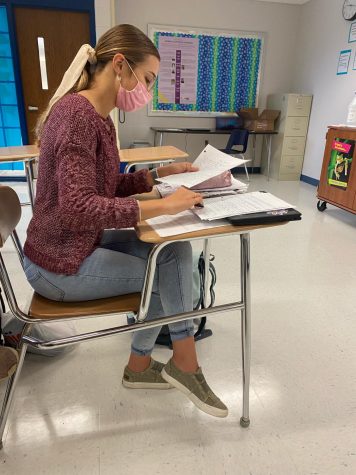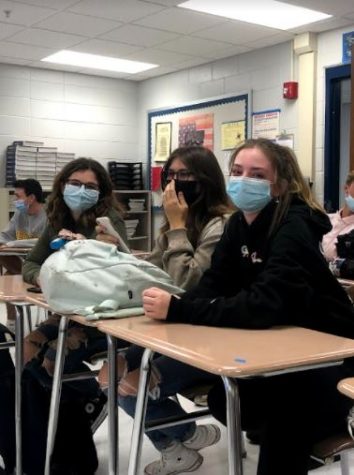Stopping the spread requires the right mask

During this pandemic, it’s common knowledge that face masks are highly recommended–and even required to be worn– in most places.
Masks work “as a simple barrier to help prevent respiratory droplets from traveling into the air and onto other people when the person wearing the mask coughs, sneezes, talks, or raises their voice,” Nurse Kline said.
This is referred to as source control, which helps greatly in preventing the spread of COVID-19. But what specific masks work the best?
One of the least recommended masks is the gaiter. In fact, studies have shown that wearing a gaiter is worse than wearing no mask at all.
Gaiters are not made for medical purposes, but rather for athletic use, and made out of polyester, which does not work for filtration. Because of the thin material that they’re made of, it cannot contain particles that exit your mouth when you speak. In fact, the gaiter does the exact opposite. The material breaks down the particles to be even smaller which causes them to linger in the air much longer than if you weren’t wearing a mask at all.
This same logic applies to bandannas or tee-shirt material. They may work okay for keeping particles out, but they are counter productive for keeping particles in.
Although, some gaiters are not made out of polyester. Some may be made out of cotton and have multiple layers. If this is the case, then the gaiter will be able to provide effective filtration and protection for the wearer and others around. For this reason, most gaiters not CDC recommended, but the ones made out of a reliable material, like cotton, are recommended.
Another mask that may be commonly seen are masks with valves or vents on the side. Although these masks may look more effective, they present almost the exact same problem as gaiters. These masks are made for people who work in construction and are around dust and other particles that are harmful to breathe in. They filter out the air that comes in, but not the air you breathe out.
The CDC has stated that these masks do not work for preventing the spread of COVID-19 and are not recommended.
Disposable masks are one of the most worn type of masks; they’re convenient and you can buy them in bulk, however these masks do have their flaws.
Although they were designed for medical purposes, they are more meant to protect people from the wearer. And even then, filtration heavily varies. Some of these masks can perform extremely well and even protect the wearer, while others might not provide any protection at all.
Another downside to these masks is that they are horrible for the environment. It is estimated that these masks will take around 450 years to completely bio-degrade, if not already consumed by wildlife.
If using a disposable mask, make sure to dispose of it properly and keep in mind that these masks are recommended by the CDC, but not for repealed use or to be worn for hours on end.
N-95’s are great masks and perform extremely well when it comes to protecting the wearer and other people. These masks were designed to have a tight fit around the nose and have great filtration. They use static electricity to attract particles and prevents them from getting in or out. This method is highly effective and allows N-95’s to trap 95% of airborne particles.
These masks may sound too good to be true, and that’s because they are.
There are people looking to profit off of this pandemic in any way they can and because of this there are bound to be counterfeits sold. Many of these masks being sold are fake and do not provide protection. Make sure to be aware of the quality and the legitimacy of these masks before continuously wearing them out.
Another downside to these masks are even though they can be reliable, they are not recommended. “The masks recommended are not surgical masks or N-95 respirators.” says Mrs. Kline,”Those are critical supplies that must continue to be reserved for healthcare workers and other medical first responders, as recommended by current CDC guidance.”
One of the best and most effective masks to wear is a fabric face mask. These masks commonly have multiple layers, some made of polypropylene, a plastic-based fabric that, just like N-95’s, uses static electricity to trap airborne particles and keep them contained.
After a few wears, these masks will collect germs. Because of this, Nurse Kline said that these masks “should be washed daily.” Doing this will cause the mask to lose its electric charge.
In order to get this charge back, make sure to iron it or rub it with another piece of fabric. Not only are these masks good for the environment, but they are also highly recommended by the CDC and easy to get a hold of.
Learning to wear masks at Carroll certainly has been a difficult adjustment, but according to superintendent Dr. Chris Himsel, NACS students have been great when it comes to following these rules, “handling it extremely well” and setting a good example for other schools.”
“It’s very reassuring seeing the kids following the guidelines each day,” said Dr. Himsel. “And it gives me confidence for the next semester.”
Although it may not seem like it, wearing masks does make a difference. It may be frustrating, but it’s important that everyone keeps up the good work. If a student is ever not wearing their mask properly or at all, Mrs. Kline recommends, “discreetly letting a teacher or staff member know and let them handle it from there.”

Lauren Sharp is a senior and this is their second year on the newspaper staff. They hope to bring write articles to inform students of the goings on at...








